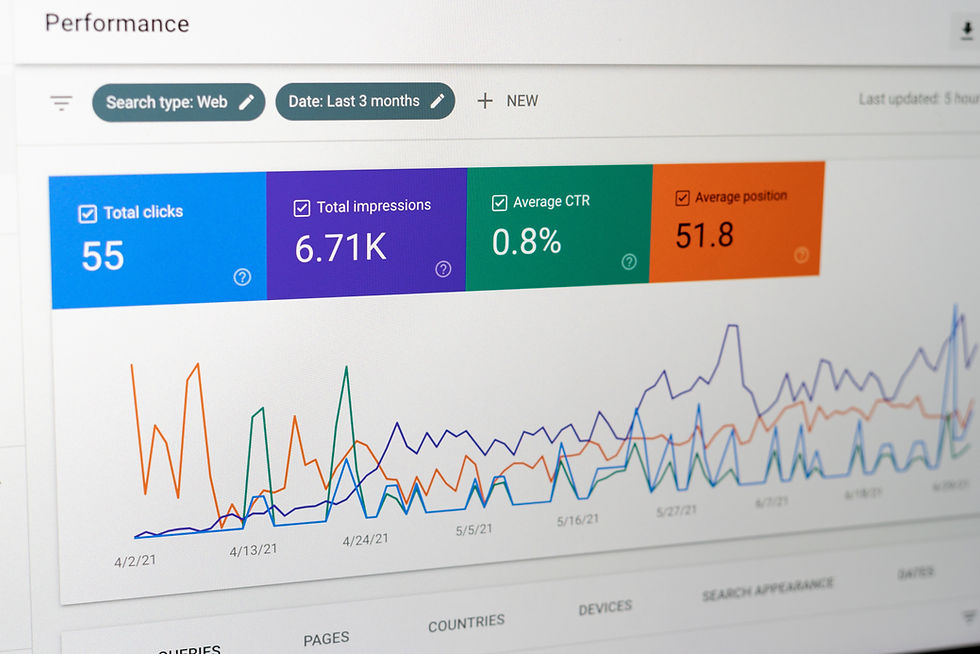7 Marketing Tips to Help Your Small Business Grow
- Collabtactics Team

- Apr 4, 2024
- 6 min read
Starting a small business is an adventure, a dream come true for many. But once the initial excitement settles, the daunting task of attracting customers begins. Here enters the superhero: Marketing! It's not just about selling products or services; it's about telling your story, sharing your passion, and connecting with people who need what you offer. But let's face it, not everyone has a marketing degree, and hiring a professional might not be in the budget. Fear not! This guide is for the brave souls, the do-it-yourselfers of the small business world. We'll walk through 7 practical marketing tips that won't require an MBA to implement but will aim to give your business the visibility it deserves. Let's get to it.

Marketing Tip 1: Know Your Audience
Understanding who you're talking to is like setting the GPS before a road trip; it guides all the decisions you make along the way. Start by asking, "Who needs my product or service?" Then dig deeper. What are their interests? Challenges? How do they prefer to shop? Gathering this information can be as simple as observing interactions on your social media, sending out a survey, or even chatting with customers. This knowledge shapes everything from the products you stock to the words you use in your ads. Remember, you're not trying to appeal to everyone, just the people who are right for your business.
Marketing Tip 2: Set Clear Goals
Imagine embarking on a treasure hunt without a map. That's what diving into marketing without clear goals can feel like. But fear not, because SMART goals are here to save the day. SMART stands for Specific, Measurable, Achievable, Relevant, and Time-bound. Whether it's increasing your social media followers by 20% in the next six months, or boosting sales by 10% in the next quarter, setting SMART goals gives you a clear target to aim for.
Think about what success looks like for your business. Maybe it's building a robust online presence, expanding your local customer base, or launching a new product line. Whatever your ambition, write it down, make it SMART, and you'll have a guiding star for your marketing efforts. Remember, these goals aren't set in stone; they're more like signposts that keep you on track and can be adjusted as your business grows and evolves.

Marketing Tip 3: Embrace Social Media
In today's digital age, social media is the town square where businesses and customers meet, greet, and interact. The key is not to be everywhere but to be where your audience is. Do they hang out on Instagram, scrolling through visually appealing posts? Or are they more likely to engage in the fast-paced conversations on Twitter? Perhaps they prefer the professional setting of LinkedIn? Select one or two platforms to start with, based on where your target audience spends their time.
Creating engaging content is your next mission. It could be anything from behind-the-scenes peeks into your business, how-to videos, customer testimonials, or simply posts that entertain, inform, and engage. Remember, consistency is key. Regular posts keep your business fresh in the minds of your audience. Don't stress about posting every day; find a rhythm that works for you and stick to it. Engage with your followers by responding to comments and messages. Social media is a two-way street, and the more you engage, the more your relationship with your audience will grow.
Marketing Tip 4: Engage With Email Marketing
Email marketing is like the secret sauce in your marketing mix. It’s direct, cost-effective, and when done right, delivers significant ROI. Starting is simpler than you might think. Begin by collecting email addresses (with permission, of course) from your customers. This can be done through sign-up forms on your website, at your physical store, or at events. Offering a small incentive, like a discount or exclusive content, can encourage sign-ups.
Next, choose an email marketing platform that suits your needs. Many user-friendly options offer templates, automation, and analytics to get you started. Your initial emails could be a welcome series introducing new subscribers to your brand, followed by regular updates about your products, services, and special offers. Remember, the goal is to add value, not just sell. Share tips, insights, or stories that your audience will find useful and engaging.
The beauty of email marketing lies in its ability to build relationships. It’s a direct line to your customers, enabling personalized communication. But beware of overdoing it; too many emails can lead to unsubscribes. Aim for a balanced frequency that keeps your business top-of-mind without overwhelming your audience.
Marketing Tip 5: Leverage Content Marketing

Content marketing is all about creating and sharing valuable content to attract and retain customers. This can be blog posts, videos, podcasts, or even infographics that inform, entertain, or solve problems for your audience. The key is to provide value without directly selling. For instance, if you run a bakery, you could share recipes, baking tips, or the story behind your most popular cake.
This approach helps establish your business as a thought leader in your industry, building trust with your audience. It also boosts your SEO efforts, as search engines love fresh, relevant content. Start by identifying topics that interest your audience and relate to your products or services. Plan a content calendar to maintain consistency, but don’t stress about volume. Quality trumps quantity every time.
Remember, content marketing is a marathon, not a sprint. It takes time to build an audience and see results, but the credibility and customer loyalty it can build are invaluable.
Marketing Tip 6: Optimize for SEO
SEO, or Search Engine Optimization, is like the compass that guides potential customers to your online doorstep. In its simplest form, SEO is about making your website more visible in search engine results when people look for products or services related to your business. Here are a few beginner-friendly tips to get you started:
Keywords: Identify words and phrases that your potential customers use to search for your products or services. Use these keywords strategically in your website's content, titles, and meta descriptions.
Mobile-Friendly Website: With more people browsing on their smartphones, ensuring your website is mobile-friendly is non-negotiable. Google loves mobile-friendly websites and ranks them higher in search results.
Quality Content: Regularly update your website with high-quality, relevant content. Blogs, customer testimonials, and product updates can keep your site fresh and engaging.
Page Speed: A slow website can hurt your rankings and turn customers away. Use tools like Google's PageSpeed Insights to check your site's speed and get suggestions for improvement.
Remember, SEO is a long-term game. It takes time and patience to see results, but the payoff is worth it. You're not just improving your search engine ranking; you're enhancing the user experience for your customers.
Marketing Tip 7: Utilize Online Advertising

While SEO works its magic in the background, online advertising can offer immediate visibility. Platforms like Google Ads and social media ads allow you to target specific demographics, interests, and even behaviors. The beauty of online advertising is its flexibility. You can start small, test different ads, and adjust your budget based on what’s working.
For small businesses, Facebook and Instagram ads can be particularly effective, thanks to their advanced targeting options. You can define your audience by age, interests, behaviors, and more. Plus, with visual ads, you can really let your brand’s personality shine.
The key is to keep your ads relevant and engaging. Use high-quality images or videos, clear calls-to-action (CTAs), and direct links to the products or services featured in your ad. Also, keep an eye on your ad’s performance and tweak your strategy as needed to ensure the best return on your investment.
Online advertising might feel like a big step, but it’s an investment in your business's growth. With a bit of experimentation and patience, you can find the formula that works best for your brand.
Summary:
These are just a few marketing tips to get you started on your DIY marketing journey. Remember that marketing is more of a marathon vs. a sprint. However, if you stay consistent you have a better chance of winning your personal race to success. If you would like someone else to take on the tasks of marketing for you, I am happy to step in. Let's get to work.



Comments